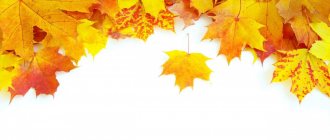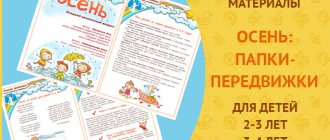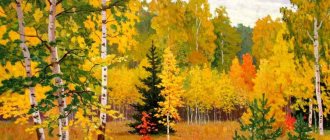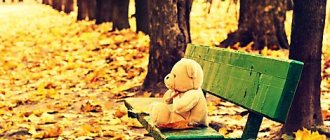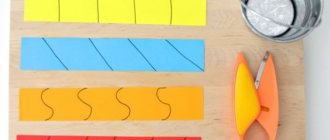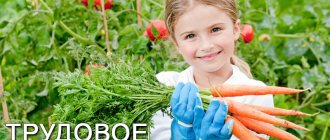Consultation for parents “Autumn has come to visit us” (you need to know this!)
Consultation for parents “Autumn has come to visit us” (you need to know this!)
To grow up healthy, a child needs to be in the fresh air. During walks, the baby expands his understanding of the world around him and gains impressions.
Nature observation
In the fall, try to make your walks with your child as varied as possible. Do not forget to observe with your child everything living and inanimate in nature, teach him to see changes in it. For example, choose one tree near your house, and every day note what changes happen to it. Show yellow, orange, red leaves on trees and bushes. Explain to your child the meaning of the word “leaf fall.” Find leaves of different trees: birch, maple, rowan, oak. Look at them carefully, let your child try to draw them on paper after returning home, and you help him. During a walk, you can tell your child that vegetables are being harvested in the autumn, that potatoes, cabbage and beets are harvested in the fields using special equipment, the harvest is put into storage, processed and then transported to stores. Tell us that some birds are called migratory because they always fly away from us in the fall. With the onset of cold weather, insects hid in cracks and under the bark of trees. Please note that not all birds are migratory, that some birds (bullfinches, waxwings) come to us for the winter, and with the onset of cold weather it becomes difficult for birds to get food for themselves, so many people simply feed them, or make feeders where they pour millet and seeds. This way, the birds can overwinter and wait until spring. You can take seeds and some bread with you on a walk to feed the birds. Tell us about animals in autumn: animals prepare supplies for the winter; the hare changes his summer coat to a winter one; the bear hibernates and sleeps until spring, and its body takes nutrition from the subcutaneous fat accumulated in the summer. What may be interesting for a child is that when a pond or river is covered with ice, the temperature of the water under the ice remains warm enough so that the fish in the pond do not freeze. Teach your child to perceive the environment in all its diversity. Listen to the sounds of autumn nature: the sound of the wind, the rustling of leaves, the rustle of rain, the cries of flying birds. Try to make the speech addressed to the baby clear to him, calm in tone, but emotional and rich in intonations.
Autumn crafts.
Collect autumn leaves and bring them home to make herbariums, appliqués and other interesting crafts. While walking in the park or in the forest, pick up cones, chestnuts, acorns, and bunches of rowan berries. The child will enjoy the process of picking fruits. To make crafts, buy wire from a flower shop that holds the desired shape well. Additional craft elements can be made from plasticine, matches, and colored paper.
Consultation for parents in the second junior group “Autumn”
Nina Chernyshova
Consultation for parents in the second junior group “Autumn”
Childhood is a unique and magical time , and there are no cloudy days, no piercing winds, no cold rain. For a child, there are no obstacles in the form of autumn slush - he is drawn to the street, where he loves to play at any time of the year and in any weather. Let’s enjoy life with our children, because it’s no coincidence that they say that nature has no bad weather!” And to help children notice the changes occurring in nature in the fall , parents need to admire this wonderful time of year with their child.
Parents are advised:
Invite your child to guess the riddle: “The fields are empty, the ground is getting wet, the day is waning, when does this happen?”
;
Tell your child about autumn , about the changes taking place in nature;
Look at pictures depicting early and late autumn , paying special attention to the appearance and condition of the trees: in early autumn they are covered with colorful foliage, and in late autumn they are bare ;
Together with your child, compare the clothes of people in early and late autumn ;
Draw his attention to how the weather has changed: have the days become longer or shorter, has it become warmer or colder outside? Tell where and why the birds flew away;
Learn the poem with your child:
- tell your child about autumn , about what changes are happening in nature;
- look at pictures depicting early and late autumn , paying special attention to the appearance and condition of the trees: in early autumn they are covered with colorful foliage, and in late autumn they are bare ;
- together with your child, compare people’s clothes in early and late autumn ;
- draw his attention to how the weather has changed: have the days become longer or shorter, has it become warmer or colder outside? Tell where and why the birds flew away
Learn the poem with your child:
Gifts of autumn .
is walking in our park , autumn gives gifts to everyone :
Red beads for rowan, pink apron for aspen,
A yellow umbrella is for poplars; autumn gives us .
Question: To whom does autumn ?
Learn the riddle.
We saw him dressed in spring and summer, but in the fall all the shirts were ripped off the poor thing. (tree)
Didactic game “What trees do you know? Name them?
.
Must know and name parts of trees (trunk, roots, branches, leaves)
.
Learn to form adjectives: birch leaf - birch, oak leaf - oak, maple leaf - maple, aspen leaf - aspen.
Learn to correctly form the plural of words: tree, trunk, birch, oak, rowan, poplar, aspen, maple.
Draw a tree in early autumn and late autumn . (What is the difference)
“Tell me what you will wear for a walk in the fall , what you will take with you in order not to get wet.”
Dear parents ! If you listen to these recommendations, your child will be very grateful to you, as his stock of knowledge will be enriched, previously acquired knowledge will be consolidated, and the ability to notice the beauty around him will develop! And most importantly, he will be pleased and interested in communicating with you!
We wish you success in raising your children!
Countdown
A month or two before kindergarten, and then right the day before, you should bring your child to kindergarten so that he gets to know this place and his teacher . Such an acquaintance will help the child feel more confident, and the sight of a huge number of toys often makes children want to take a closer look at them...
Train your baby: put him to bed and wake him up in accordance with schedule .
The first few days, or even better, a week or two, you should have more free time : the child will have the opportunity to gradually get used to the new regime, and he will not have to immediately spend a long 8, or even 9 hours a day in kindergarten.
The task of parents is to find a solution to this problem: sometimes a mother takes the child with her for lunch, someone hires a nanny to pick him up early. In any case, during the first year it is necessary to help the child adapt to new conditions.
MAGAZINE Preschooler.RF
Consultation for parents “How to explain to a child what autumn is for young children?”Completed by the teacher of GBDOU No. 82 of the Moskovsky district of St. Petersburg Oksana Mikhailovna Arkhipova
Goals:
- Teach children to name the signs of autumn, changes in the weather, and use figurative words and expressions for autumn;
- learn to compare essential features of phenomena;
- Expand children's horizons about natural changes in autumn, about the life of birds and wild animals;
- Carry out fun walks for kids with their parents;
- Get a clear idea of seasonal phenomena through walks with your parents;
- To cultivate attention, love of nature, caring attitude towards animals, birds, positive character traits.
- Convey color combinations characteristic of late autumn in the drawing.
What is autumn?
How to make an autumn walk interesting and interesting for children
cognitive? What can you do with your child on a walk in the fall?
Autumn is a transitional season, at this time nature changes very quickly. First, bright colors appear, then the leaves fall from the trees, and they become gray and dull. The air temperature drops, and the child understands that it is getting colder outside every day. Clothes become bulky, heavy and not very comfortable. But it is precisely at this time of year that it is easy to attract children's attention to nature, interest them and show them how life works. “Herbarium” One of the most interesting activities at this time of year is assembling a herbarium and making crafts from natural materials.
Every season feels like the first time for kids. Therefore, it is important to give them the opportunity to learn the concept of seasons through experience. This will form the basis of a coherent picture of the world. Fortunately, solving such a problem is not at all difficult.
Surveillance in the yard
Let's look around and think - what has changed in the usual picture with the arrival of autumn? Let one - a single tree - grow in the yard and it can become a wonderful resource. Come up to it every few days - look at and touch the leaves. Swinging on a swing, you can “fly with the birds” to warmer climes. And admire the color of the autumn sky. In the sandbox - touch the cool sand and pay attention to the warm clothes of your friends. And then go with them in search of thin crusts of ice. If you hold this transparent, fragile miracle in your hand, the baby will see and feel it. How a cold piece of ice turns into a warm drop before your eyes. That's the trick.
Walk to the park
Here you can admire the colors of autumn. Inhale its unique aroma! Go for a walk in the park or forest more often - both on fine leaf days and on cloudy days. "Magical nature" .
This activity consists of simply walking, observing, listening to the sounds around you: the rustling of leaves under your feet, the chirping of birds. While walking, remember the signs of autumn, and maybe you will see a flying cobweb or a lot of rowan berries on the trees.
Signs of autumn
- Squirrels make a large supply for the winter - expect severe frosts in winter.
- There are a lot of rowan trees, which means that the autumn will be rainy and the winter will be frosty.
- Migratory birds fly high - the cold is already approaching.
- If the leaves fall from the trees very quickly, then the winter will be cold.
- The leaves from the birch trees fall unevenly—there won’t be any snow for a long time.
- A cat hides its face and covers it with its tail - it means it will get colder.
Where else can you find so many interesting objects to explore?! Moreover, you can touch, feel, smell all this. Give your baby complete freedom.
Are you worried about the condition of your clothes after a walk? Bring spare clothes with you. And let your child have fun for his own pleasure, for example, collecting armfuls of fallen leaves...
In different parts of the park you can observe the diversity of landscapes and plants. Today you will admire the spreading maple and collect an elegant bouquet under it. Tomorrow add rowan branches to the composition. Oak will rightfully take pride of place in walks. One day he discovered a smooth acorn under it, and even with a cute cap.
Conversation
How can you make a walk even more beneficial for your child’s development?
Pay attention to individual elements of the world around you. Take a leaf in your hand, place a ladybug on your palm, and run your baby’s hand along the bark of the tree.
Speak out everything you are considering, mark the signs and properties with words. “Here is a maple leaf. Wide carved, similar to your palm. This one is yellow. And here is the red one .
Develop musical abilities, aesthetic taste, the ability to show emotional responsiveness to music, develop creativity and creativity.
Encourage them to express their impressions of listening to classical works in creative activities, performing arts, and speech activities.
Photograph your child against a luxurious backdrop, and don't forget to photograph everything around him. Such photographs will help to revive your memory of a recent walk and consolidate your impressions.
Procurement of natural material
You can collect natural materials all year round, as each season has its own charms. Autumn provides a particularly rich palette of colors with the golden and crimson leaves of autumn trees.
Harvested natural material can be used in creative works. The more diverse the collected material, the easier it will be to work with it. But the leaves can be used in applique, giving it different shades or as a background. Spruce and pine cones can be used in working with plasticine, making a variety of forest animals. The collected dry roots, branches, cones, and twigs have a bizarre shape. You can invite children to answer the following questions:
“What does it look like? What does it remind you of? This encourages the children to compare them, remember familiar fairy-tale characters, carefully look at the material, think through their imagination in advance, what can be made from it, what composition can be created (with the participation of people, animals, birds, fish, etc.).
| Next > |
How to prepare your child for kindergarten
Three months before starting kindergarten, start talking about it with your child. Psychological preparation of a child takes time.
Extol the advantages of kindergarten: there you can play with the kids and make friends. Talk about what he will do there, what new things he will be able to learn, thereby making you feel proud. Describe his new daily routine, specifying which days he will go to kindergarten, tell him what changes await him in his daily life, and reassure him if he is worried about something.
It will be much easier for your child in kindergarten if you have taught him to be independent . Buy him clothes that are easy to take off and put on - pants with elastic instead of overalls, boots with Velcro instead of laces...
It is necessary to develop qualities useful for life in a team . Encourage your child to be cooperative and tolerant: at the table, ask him to wait his turn; do not give in to it in games; ask him for help around the house - getting clothes out of the washing machine, for example, won’t be too difficult for him...
Teach your child to follow instructions . You can do this in the form of a game: “Go to your room, take your bunny and put it on the TV.” Start with two directions, then if the child gets it right three times in a row, increase the number.
Give your child the opportunity to spend time with peers - invite the children of your friends to your home, take him to the park and playground more often.
How to help your child adapt to the kindergarten regime?
The child should get enough sleep at night - this is the only source of recuperation. It is advisable that a calm atmosphere reign in the house and that the TV is turned off.
Children need greens, fresh vegetables and fruits, grains and dairy products. Ask the teachers what they feed in the kindergarten, and try to balance the kindergarten food with homemade dishes . Avoid snacking and limit your intake of sweets.
Don't let your child watch TV . Noise and frequent changes of personnel do not in any way contribute to relaxation. And no TV before bed! It's better to take him for walks in nature.
Another source of fatigue is extracurricular activities : parents want their child to learn to swim, speak English and play the piano. Take it easy! At home, the child has every right to be idle.
First weeks in the garden
During the first few weeks of kindergarten, it may not be easy for the child: whims, increased excitability, and even attacks of severe fatigue are possible.
In addition to the difficulties of getting used to new rules and surroundings, the daily routine of a kindergarten does not take into account the child’s own biological rhythms: he sleeps little, he has to constantly do something and strain his attention, and there is little time for proper rest.
It is quite difficult for active children to behave calmly for several hours a day. It is not surprising that after kindergarten, children seem to break loose... They simply need to scream, run, jump... This need must be treated with due respect. Others, on the contrary, need to be alone in peace and quiet with their toys, to dream. This need must be respected in the same way.
